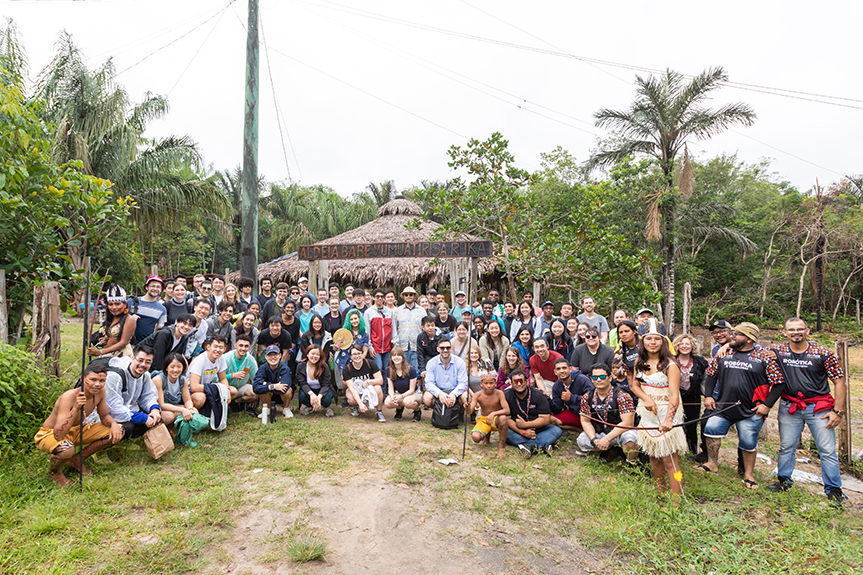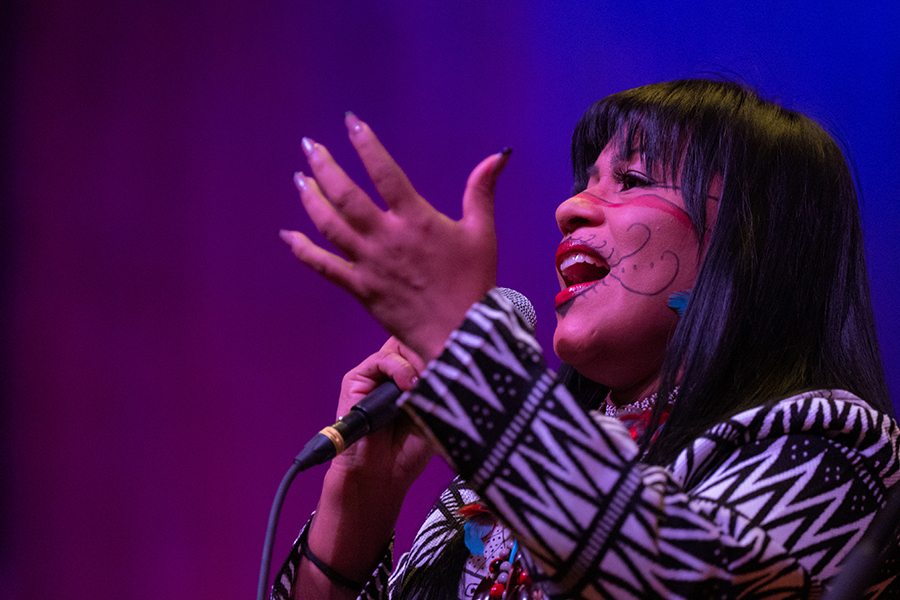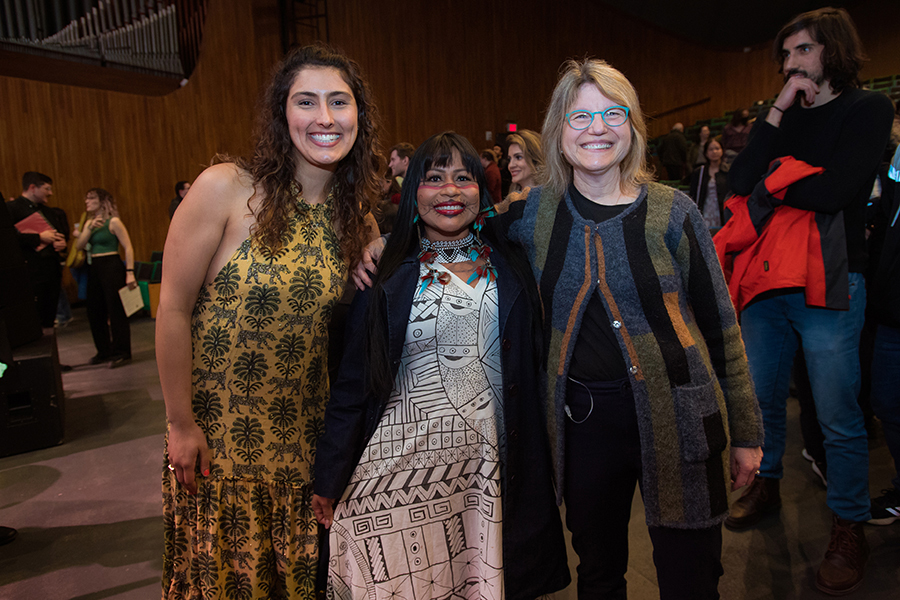On Dec. 13, the MIT community came together for the premiere of “We Are The Forest,” a documentary by MIT Video Productions that tells the story of the MIT musicians who traveled to the Brazilian Amazon seeking culture and scientific exchange.
The film features performances by Djuena Tikuna, Luciana Souza, Anat Cohen, and Evan Ziporyn, with music by Antônio Carlos Jobim. Fred Harris conducts the MIT Festival Jazz Ensemble and MIT Wind Ensemble and Laura Grill Jaye conducts the MIT Vocal Jazz Ensemble.
The impact of ecological devastation in the Amazon reflects the climate crisis worldwide. During the Institute's spring break in March 2023, nearly 80 student musicians became only the second student group from MIT to travel to the Brazilian Amazon. Inspired by the research and activism of Talia Khan ’20, who is currently a PhD candidate in MIT's Department of Mechanical Engineering, the trip built upon experiences of the 2020-21 academic year when virtual visiting artists Luciana Souza and Anat Cohen lectured on Brazilian music and culture before joining the November 2021 launch of Hearing Amazônia — The Responsibility of Existence.
This consciousness-raising project at MIT, sponsored by the Center for Art, Science and Technology (CAST), began with a concert featuring Brazilian and Amazonian music influenced by the natural world. The project was created and led by MIT director of wind and jazz ensembles and senior lecturer in music Frederick Harris Jr.
The performance was part eulogy and part praise song: a way of bearing witness to loss, while celebrating the living and evolving cultural heritage of Amazonia. The event included short talks, one of which was by Khan. As the first MIT student to study in the Brazilian Amazonia (via MISTI-Brazil), she spoke of her research on natural botanical resins and traditional carimbó music in Santarém, Pará, Brazil. Soon after, as a Fulbright Scholar, Khan continued her research in Manaus, setting the stage for the most complex trip in the history of MIT Music and Theater Arts.
“My experiences in the Brazilian Amazon changed my life,” enthuses Khan. “Getting to know Indigenous musicians and immersing myself in the culture of this part of the world helped me realize how we are all so connected.”
“Talia’s experiences in Brazil convinced me that the Hearing Amazônia project needed to take a next essential step,” explains Harris. “I wanted to provide as many students as possible with a similar opportunity to bring their musical and scientific talents together in a deep and spiritual manner. She provided a blueprint for our trip to Manaus.”
An experience of a lifetime
A multitude of musicians from three MTA ensembles traveled to Manaus, located in the middle of the world’s largest rainforest and home to the National Institute of Amazonian Research (Instituto Nacional de Pesquisas da Amazônia, or INPA), the most important center for scientific studies in the Amazon region for international sustainability issues.
Tour experiences included cultural/scientific exchanges with Indigenous Amazonians through Nobre Academia de Robótica and the São Sebastião community on the Tarumã Açu River, INPA, the Cultural Center of the Peoples of the Amazon, and the Museu da Amazônia. Musically, students connected with local Indigenous instrument builders and performed with the Amazonas State Jazz Orchestra and renowned vocalist and Indigenous activist Djuena Tikuna.
“Hearing Amazônia: Arte ê Resistência,” a major concert in the famed 19th century opera house Teatro Amazonas, concluded the trip on March 31. The packed event featured the MIT Wind Ensemble, MIT Festival Jazz Ensemble, MIT Vocal Jazz Ensemble, vocalist Luciana Souza, clarinetist Anat Cohen, MIT professor and composer-clarinetist Evan Ziporyn, and local musicians from Manaus. The program ended with “Nós Somos A Floresta (We Are The Forest) — Eware (Sacred Land) — Reflections on Amazonia,” a large-scale collaborative performance with Djuena Tikuna. The two songs were composed by Tikuna, with Eware newly arranged by Israeli composer-bassist Nadav Erlich for the occasion. It concluded with all musicians and audience members coming together in song: a moving and beautiful moment of mediation on the sacredness of the earth.
“It was humbling to see the grand display of beauty and diversity that nature developed in the Amazon rainforest,” reflects bass clarinetist and MIT sophomore Richard Chen. “By seeing the bird life, sloths, and other species and the flora, and eating the fruits of the region, I received lessons on my harmony and connection to the natural world around us. I developed a deeper awareness of the urgency of resolving conflicts and stopping the destruction of the Amazon rainforest, and to listening to and celebrating the stories and experiences of those around me.”
Indigenous musicians embodying the natural world
“The trip expanded the scope of what music means,” MIT Vocal Jazz Ensemble member and biomedical researcher Autumn Geil explains. “It’s living the music, and you can’t feel that unless you put yourself in new experiences and get yourself out of your comfort zone.”
Over two Indigenous music immersion days, students spent time listening to, and playing and singing with, musicians who broadened their scope of music’s relationship to nature and cultural sustainability. Indigenous percussionist and instrument builder Eliberto Barroncas and music producer-arranger César Lima presented contrasting approaches with a shared objective — connecting people to the natural world through Indigenous instruments.
Barroncas played instruments built from materials from the rainforest and from found objects in Manaus that others might consider trash, creating ethereal tones bespeaking his life as one with nature. Students had the opportunity to play his instruments and create a spontaneous composition playing their own instruments and singing with him in a kind of “Amazonia jam session.”
“Eliberto expressed that making music is visceral; it’s best when it comes from the gut and is tangible and coming from one’s natural environment. When we cannot understand each other using language, using words, logic and thinking, we go back to the body,” notes oboist and ocean engineer Michelle Kornberg ’20. “There's a difference between teaching music as a skill you learn and teaching music as something you feel, that you experience and give — as a gift.”
Over the pandemic, César Lima developed an app, “The Roots VR,” as a vehicle for people to discover over 100 Amazonia instruments. Users choose settings to interact with instruments and create pieces using a variety of instrumental combinations; a novel melding of technology with nature to expand the reach of these Indigenous instruments and their cultural significance.
At the Cultural Center of the Peoples of the Amazon, students gathered around a tree, hand-in-hand singing with Djuena Tikuna, accompanied by percussionist Diego Janatã. “She spoke about being one of the first Indigenous musicians ever to sing in the Teatro Amazonas, which was built on the labor and blood of Indigenous people,” recalls flutist and atmospheric engineer Phoebe Lin, an MIT junior. “And then to hold hands and close our eyes and step back and forth; a rare moment of connection in a tumultuous world — it felt like we were all one.”
Bringing the forest back to MIT
On April 29, Djuena Tikuna made her MIT debut at “We Are the Forest — Music of Resilience and Activism,” a special concert for MIT President Sally Kornbluth’s inauguration, presenting music from the Teatro Amazonas event. Led and curated by Harris, the performance included new assistant professor in jazz and saxophonist-composer Miguel Zenón, director of the MIT Vocal Jazz Ensemble; Laura Grill Jaye; and vocalist Sara Serpa, among others.
“Music unites people and through art we can draw the world’s attention to the most urgent global challenges such as climate change,” says Djuena Tikuna. “My songs bring the message that every seed will one day germinate to reforest hearts, because we are all from the same village.”
Hearing Amazônia has set the stage for the blossoming of artistic and scientific collaborations in the Amazon and beyond.
“The struggle of Indigenous peoples to keep their territories alive should concern us all, and it will take more than science and research to help find solutions for climate change,” notes President Kornbluth. “It will take artists, too, to unite us and raise awareness across all communities. The inclusivity and expressive power of music can help get us all rowing in the same direction — it’s a great way to encourage us all to care and act!”

















